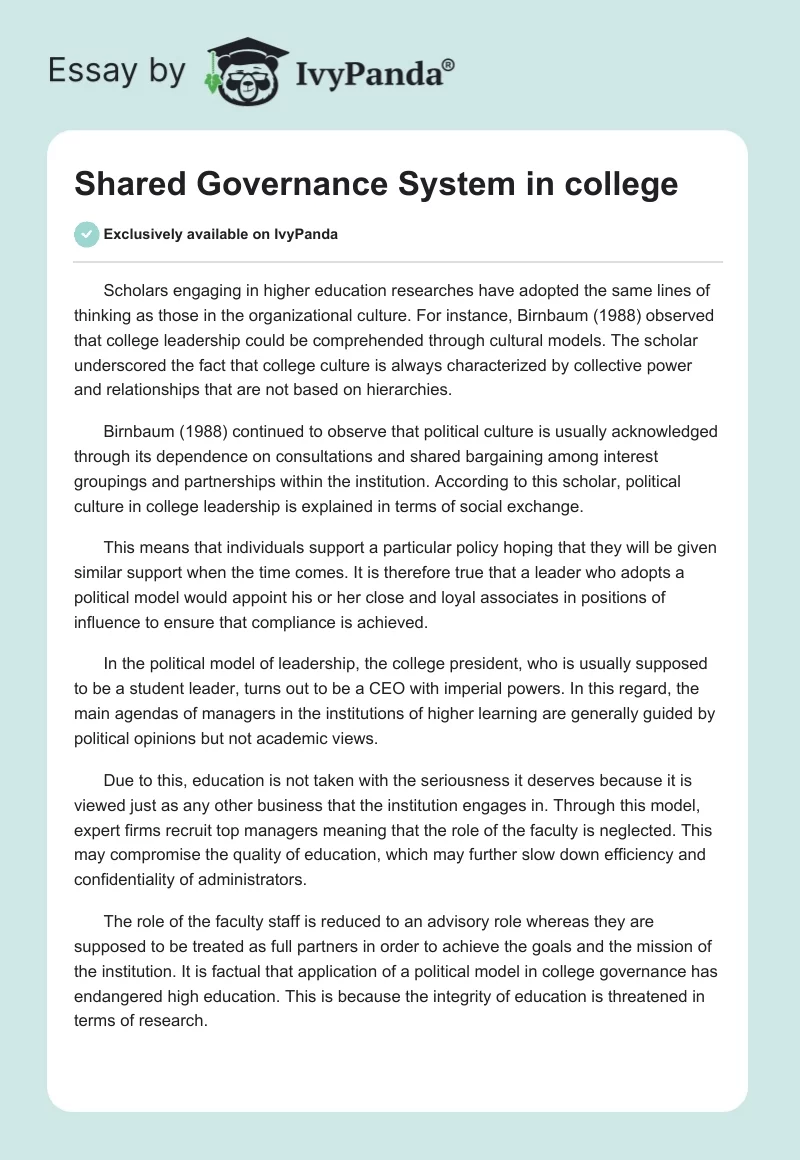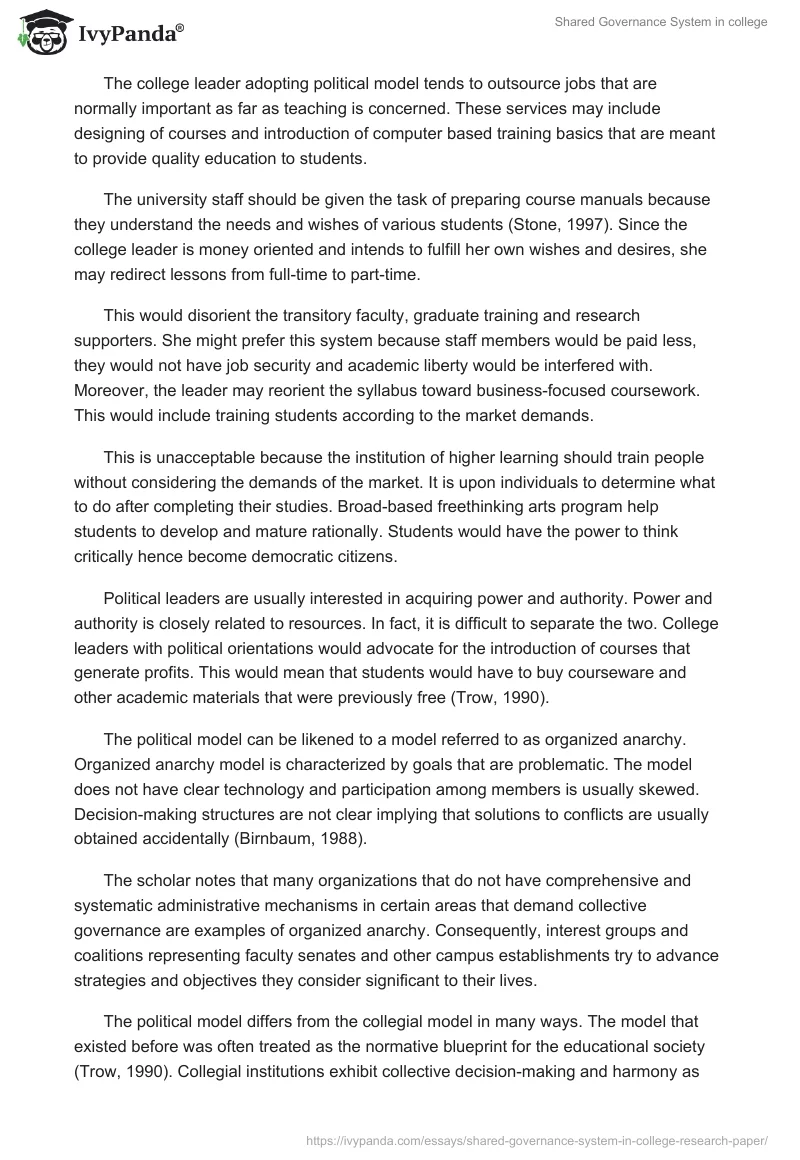Scholars engaging in higher education researches have adopted the same lines of thinking as those in the organizational culture. For instance, Birnbaum (1988) observed that college leadership could be comprehended through cultural models. The scholar underscored the fact that college culture is always characterized by collective power and relationships that are not based on hierarchies.
Birnbaum (1988) continued to observe that political culture is usually acknowledged through its dependence on consultations and shared bargaining among interest groupings and partnerships within the institution. According to this scholar, political culture in college leadership is explained in terms of social exchange.
This means that individuals support a particular policy hoping that they will be given similar support when the time comes. It is therefore true that a leader who adopts a political model would appoint his or her close and loyal associates in positions of influence to ensure that compliance is achieved.
In the political model of leadership, the college president, who is usually supposed to be a student leader, turns out to be a CEO with imperial powers. In this regard, the main agendas of managers in the institutions of higher learning are generally guided by political opinions but not academic views.
Due to this, education is not taken with the seriousness it deserves because it is viewed just as any other business that the institution engages in. Through this model, expert firms recruit top managers meaning that the role of the faculty is neglected. This may compromise the quality of education, which may further slow down efficiency and confidentiality of administrators.
The role of the faculty staff is reduced to an advisory role whereas they are supposed to be treated as full partners in order to achieve the goals and the mission of the institution. It is factual that application of a political model in college governance has endangered high education. This is because the integrity of education is threatened in terms of research.
The college leader adopting political model tends to outsource jobs that are normally important as far as teaching is concerned. These services may include designing of courses and introduction of computer based training basics that are meant to provide quality education to students.
The university staff should be given the task of preparing course manuals because they understand the needs and wishes of various students (Stone, 1997). Since the college leader is money oriented and intends to fulfill her own wishes and desires, she may redirect lessons from full-time to part-time.
This would disorient the transitory faculty, graduate training and research supporters. She might prefer this system because staff members would be paid less, they would not have job security and academic liberty would be interfered with. Moreover, the leader may reorient the syllabus toward business-focused coursework. This would include training students according to the market demands.
This is unacceptable because the institution of higher learning should train people without considering the demands of the market. It is upon individuals to determine what to do after completing their studies. Broad-based freethinking arts program help students to develop and mature rationally. Students would have the power to think critically hence become democratic citizens.
Political leaders are usually interested in acquiring power and authority. Power and authority is closely related to resources. In fact, it is difficult to separate the two. College leaders with political orientations would advocate for the introduction of courses that generate profits. This would mean that students would have to buy courseware and other academic materials that were previously free (Trow, 1990).
The political model can be likened to a model referred to as organized anarchy. Organized anarchy model is characterized by goals that are problematic. The model does not have clear technology and participation among members is usually skewed. Decision-making structures are not clear implying that solutions to conflicts are usually obtained accidentally (Birnbaum, 1988).
The scholar notes that many organizations that do not have comprehensive and systematic administrative mechanisms in certain areas that demand collective governance are examples of organized anarchy. Consequently, interest groups and coalitions representing faculty senates and other campus establishments try to advance strategies and objectives they consider significant to their lives.
The political model differs from the collegial model in many ways. The model that existed before was often treated as the normative blueprint for the educational society (Trow, 1990). Collegial institutions exhibit collective decision-making and harmony as regards to professionalism and college issues. The model insists on the specialized power of the faculty to come up with important college and institutional solutions.
Furthermore, a strong sense of fairness encompasses the academic activity on college models. Stone (1997) posits that in the collegial archetype, relations among the entire college population are wide-ranging and casual, and conclusions are frequently achieved through compromise after systematic and extensive considerations.
The task of the management is to execute the wishes and the desires of the collegiums. This would mean that institutional behavior is consistent. Whereas the collegial model may perhaps be vaguer than actual, college faculties definitely endeavor for harmony in educational management.
The shift from college model to political model affects both students and college staff in many ways. The college staff may not offer quality services since their positions and roles are neglected.
They are only allowed to offer advice to college leaders, a role that does not please them. Students may not get quality services because leaders are only interested in fulfilling their wishes and desires. This leads to exploitation. In any case, working in a political climate is enjoyable since there is freedom of speech and expression.
References
Birnbaum, R. (1988). How colleges work: the cybernetics of academic organization and leadership. San Francisco, CA: Jossey-Bass.
Stone, D. (1997). Policy paradox: The art of political decision-making. New York, NY: W. W. Norton & Company.
Trow, M. (1990). The academic senate as a school for university leadership. Liberal Education, 76(1), 23-27.


